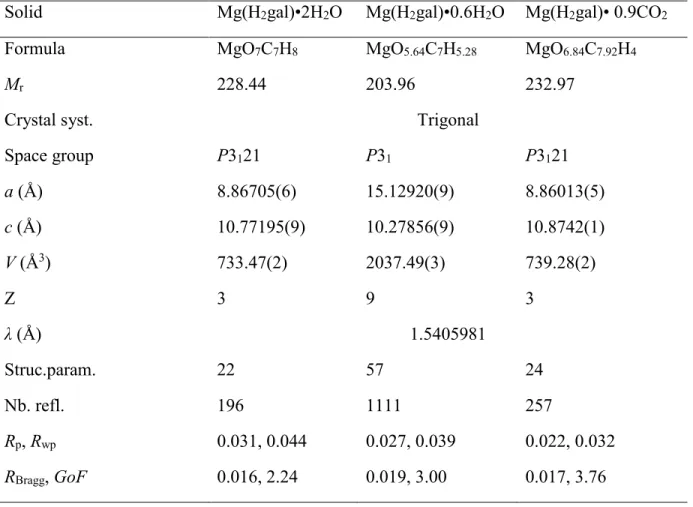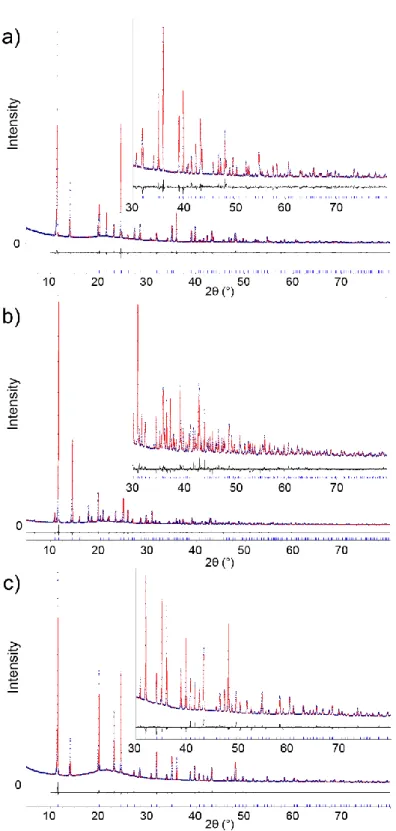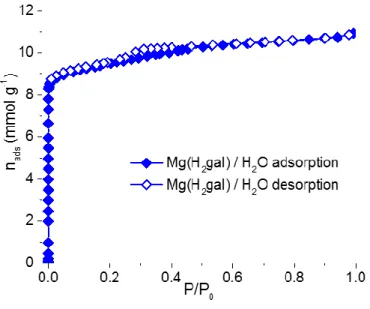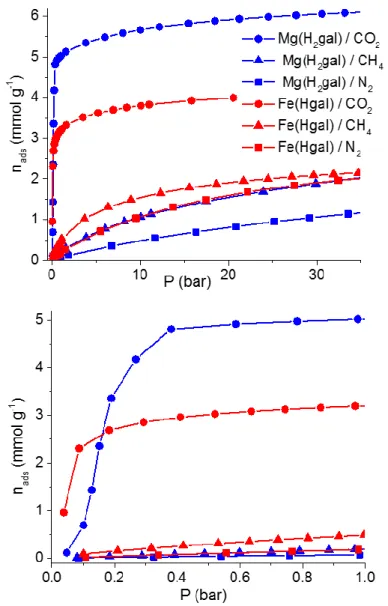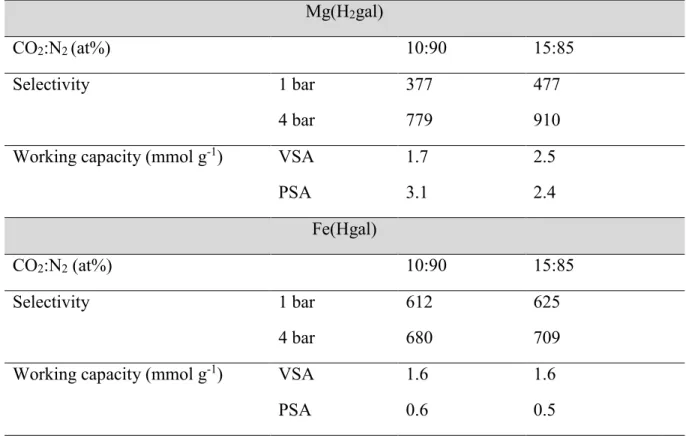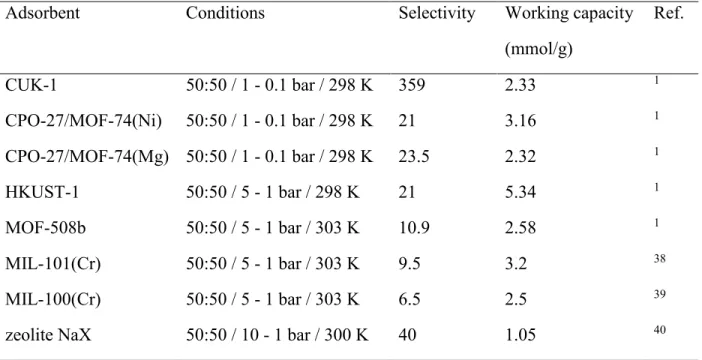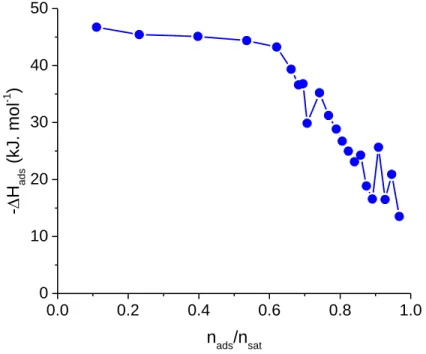HAL Id: hal-02493857
https://hal.archives-ouvertes.fr/hal-02493857
Submitted on 2 Dec 2020HAL is a multi-disciplinary open access archive for the deposit and dissemination of sci-entific research documents, whether they are pub-lished or not. The documents may come from teaching and research institutions in France or abroad, or from public or private research centers.
L’archive ouverte pluridisciplinaire HAL, est destinée au dépôt et à la diffusion de documents scientifiques de niveau recherche, publiés ou non, émanant des établissements d’enseignement et de recherche français ou étrangers, des laboratoires publics ou privés.
Small-Pore Gallates MOFs for Environmental
Applications: Sorption Behaviors and Structural
Elucidation of Their High Affinity for CO 2
Nicolas Heymans, Sandrine Bourrelly, Périne Normand, Emily Bloch, Hassan
Mkhadder, Lucy Cooper, Martin Gorman, Intissar Bouzidi, Nathalie Guillou,
Guy de Weireld, et al.
To cite this version:
Nicolas Heymans, Sandrine Bourrelly, Périne Normand, Emily Bloch, Hassan Mkhadder, et al.. Small-Pore Gallates MOFs for Environmental Applications: Sorption Behaviors and Structural Elucidation of Their High Affinity for CO 2. Journal of Physical Chemistry C, American Chemical Society, 2020, 124 (5), pp.3188-3195. �10.1021/acs.jpcc.9b11535�. �hal-02493857�
Small Pore Gallates MOFs for Environmental
Applications: Sorption Behaviors and Structural
Elucidation of their High Affinity for CO
2
Nicolas Heymans,a Sandrine Bourrelly, b Perine Normand,a Emily Bloch,b Hassan Mkhadder,c
Lucy Cooper,d Martin Gorman,d Intissar Bouzidi,c Nathalie Guillou,d* Guy De Weireld,a*
Thomas Deviccd*.
a Service de Thermodynamique et de Physique mathématique, Faculté Polytechnique, Université
de Mons, 20, place du Parc, 7000 Mons, Belgium.
b MADIREL, UMR CNRS 7246, Université Aix-Marseille, Centre de St Jérôme, 13013
Marseille, France.
c Institut des Matériaux Jean Rouxel (IMN), UMR 6502, CNRS Université de Nantes, 2 rue de la
Houssinière, 44322 Nantes cedex 3, France.
d Institut Lavoisier, UMR CNRS 8180, Université de Versailles St-Quentin-en-Yvelines,
Université Paris-Saclay, 45 Avenue des Etats-Unis, 78035 Versailles cedex, France.
AUTHOR INFORMATION
ABSTRACT The ability of two structurally related small pore Metal Organic Frameworks (MOFs)
to capture CO2 was investigated by a combination of gas sorption measurements, X-ray powder
diffraction (XRPD) analysis, microcalorimetry experiments and Ideal Adsorbed Solution Theory
(IAST) calculations. The title solids, formulated Mg(H2gal) and Fe(Hgal) (H4gal = gallic acid) are
made of a naturally occurring ligand, and were both prepared on the multigram scale under mild
conditions. They both present very similar structures, with identical channels of ca 3.5 Å diameter,
but present different amounts of acidic protons on the surface of the pores. These compounds were
found to be extremely hydrophilic, and exhibit a moderate stability towards water. Whilst their
ability to adsorb CH4 and N2 is very limited, they both adsorb significant amounts of CO2 even at
atmospheric pressure (3 and 5 mmol g-1 at 303 K for the Fe and Mg derivatives respectively). As
a consequence, these compounds present high CO2/N2 and CO2/CH4 selectivities (380-910 and
190-460 respectively) together with good working capacities, making them of interest for the
capture of CO2 from flue gas or for landfill gas upgrading in pressure swing adsorption or vacuum
swing adsorption processes. Finally, the analysis of the Mg derivative by X-Ray Diffraction (XRD)
and adsorption microcalorimetry revealed that its high affinity for CO2 relies on a strong and
specific site of adsorption involving double hydrogen bonds between the CO2 molecules and the
Introduction
After a long lasting quest for large pore Metal Organic Frameworks (MOFs) with very high
sorption capacities suitable for gas storage or gas capture, nowadays small pore MOFs are
considered with increasing interest. These solids appear particularly suitable for gas separation
purposes, especially CO2 capture,1–5 as both enhanced guest-framework interactions through
confinement and steric effects could give rise to very high selectivities, especially in the
atmospheric pressure regime.6–11 Sustainable access to these materials is also a growing concern:
the availability and toxicity of the reactants (organic and inorganic) and the solvent (not only for
the synthesis but also the activation step) could play a major role if one truly envisions these MOFs
for practical uses.12,13 Indeed, while water, and especially hydrothermal conditions, was commonly
used from the beginning of the MOF era, the benefit of this solvent in terms of sustainability is
nowadays stressed explicitly.14–18 Furthermore, preparation procedures involving solely this
solvent, under mild conditions, using earth abundant cations (such as Mg, Al, Ti, Fe) and bio
available ligands appear particularly appealing.
We have recently become interested in the use of phenolate ligands for the preparation of robust
MOFs.19–21 Specifically, we reported the preparation of a 3-D solid made a naturally occurring
phenolic derivative, namely gallic acid (H4gal), and magnesium, on the 20 g (~ 0.1 mol) scale in
water at atmospheric pressure.22 This compound, formulated Mg(H
2gal)•2H2O, is isostructural
with the already reported MII = Ni, Co, Mn solids, i.e. built up from chain of corner sharing MO 6
octahedra connected through the ligands to afford interconnected triangular channels of ca. 3.5 Å
protons on each ligand, located on the oxygen atom in meta position, as evidenced by neutron
diffraction (M = Ni, Co)23 and 2-D solid state NMR (M = Mg).22 One of the less common features
of this structure type is that it also adapts to trivalent cations. The FeIII analogue was indeed
reported in the early 90's,25,26 and presents a similar structure except for the protonation state of
the ligand, which is in this case 3/4 deprotonated, giving rise to the formula Fe(Hgal)•2H2O.
Whereas the structure and magnetic properties of these transition metal based solids were
thoroughly studied,23,27 no information about their adsorptive properties was available. Nitrogen
sorption experiments carried out at 77 K on the Mg derivative indicated that this solid is
microporous, although the small size of the pores and their high polarity, associated with the
presence of remaining acidic protons on the ligand, accounted for strong diffusion kinetics
limitation at low temperature.22 We therefore decided to investigate the sorptive properties of the
Mg and Fe based solids around room temperature (298-303 K). By using a combination of X-ray
powder diffraction (XRPD) analyses, single gases (CO2, N2, CH4) and water vapor sorption
isotherm measurements as well as gas adsorption microcalorimetry, we were able to shed some
light on the host-guest interactions of these solids, particularly on the role of acidic protons on
their sorption ability. Eventually, calculations based on the Ideal Adsorbed Solution Theory
(IAST) revealed that these compounds, which were very recently proposed for ethane-ethylene
separation,28 could also be interesting for CO
2/N2 separation in conditions relevant to CO2 capture
Figure 1. Crystal structures of Mg(H2gal)•2H2O, Mg(H2gal)•0.6H2O and Mg(H2gal)•0.9CO2.
Top: view along the channel axis; bottom: highlight on the guest –framework C-O-H•••O
hydrogen bonds.
Results and discussion
Mg(H2gal)•2H2O was prepared as previously reported.22 Several procedures were proposed to
synthesize Fe(Hgal)•2H2O, including room temperature solution routes27 or diffusion within a
gel,25 as well as conventional24,29 or microwave23 hydrothermal reactions, all starting from FeII
salts and H4gal in water. We found that under mild conditions (T = 353 K under stirring), it is
possible to produce the title solid as a polycrystalline powder from iron(II) chloride and gallic acid
on the multigram scale with a yield of ca. 65 % (see supporting information for details). XRPD
analysis confirmed that both solids belong to the expected structure type (Figure S1) and
thermogravimetric (TG) analyses showed that the water content is ca. 2 H2O per formula unit
(Figure S4). A closer look at the TG data, as well as the corresponding Differential Scanning
Calorimetry (DSC) signal, indicates that the water departure (endothermic) is almost concomitant
with the beginning of the degradation of the network (exothermic), especially in the case of iron.
The difference between FeIII and MgII based solids could be explained both by the stronger
water-phenol hydrogen bonds in the framework made of FeIII than of MgII, as already observed with other
MII cations (Ni, Co),23 which render the departure of water more difficult, as well as by the lower
thermal stability of the transition metal based solid (see Figure S4). Such a lower stability might
be intrinsic property of the material, or be related to a different amount of defects, which are known
to affect the stability of MOFs.
The high crystallinity of the Mg framework allowed us to study its dehydration by high resolution
XRPD. While under air, only a contraction of the unit cell up to the degradation of the framework
was observed,22 it was possible to isolate an intermediate form at 388 K under vacuum.
Specifically, a few additional weak diffraction peaks were clearly discernible on the XRPD pattern,
indicative of a superstructure. The diagram could indeed be indexed with a triple unit-cell (see
Table 1), and the structure was ultimately refined satisfactorily through to the Rietveld method
(see Figures 2 and S2 for the final refinement plot). Note here that single crystal analysis has
revealed a similar feature upon dehydration of Fe(Hgal)•2H2O.30 In this form, the structure
contains 3 independent cations and ligands (vs. one on twofold axes in the hydrated form), but no
change in the topology of the network occurred (see Figure 1). The structural changes mostly relate
to the strong distortion of two thirds of the MgO6 octahedra, associated with a dissymmetrisation
of the phenol-Mg bonds (half of the O(H)-Mg bonds are shortened, half are elongated, see Table
2). The coordination number of these Mg ions thus evolves from 6 to 5+1, this modification being
123.7(1) and 130.8(1)° in the present form). Regarding the gallate ligand, this distortion is
associated with a slight rotation around the phenyl-carboxylate bond (the corresponding dihedral
angles evolve from 34.9° in the hydrated form to 24.1, 31.3 and 32.1° in the present form).
Regarding the pore content, the majority (ca. 70%) of the water molecules were discarded, but the
position of the remaining molecules is very similar to the one found in the fully hydrated form22
(see Figure 1).
Table 1. Refinement parameters for Mg(H2gal)• n(guest).
Solid Mg(H2gal)•2H2O Mg(H2gal)•0.6H2O Mg(H2gal)• 0.9CO2
Formula MgO7C7H8 MgO5.64C7H5.28 MgO6.84C7.92H4
Mr 228.44 203.96 232.97
Crystal syst. Trigonal
Space group P3121 P31 P3121 a (Å) 8.86705(6) 15.12920(9) 8.86013(5) c (Å) 10.77195(9) 10.27856(9) 10.8742(1) V (Å3) 733.47(2) 2037.49(3) 739.28(2) Z 3 9 3 λ (Å) 1.5405981 Struc.param. 22 57 24 Nb. refl. 196 1111 257 Rp, Rwp 0.031, 0.044 0.027, 0.039 0.022, 0.032 RBragg, GoF 0.016, 2.24 0.019, 3.00 0.017, 3.76
Figure 2. Final Rietveld plots in the 2θ-range 5-80° (see Figure S2 for the full range) for
Mg(H2gal)•2H2O (top), Mg(H2gal)•0.6H2O (middle) and Mg(H2gal)•0.9CO2 (bottom). Inset:
Table 2. Mg-O bond distances and bond valences (BV) in Mg(H2gal)•n(guest).
Oxygen Mg-O distance (Å) BV Mg BV sum Mg(H2gal)•2H2O carboxylate 2.047(3) (x2) 0.38 2.18 m-phenol 2.183(3) (x2) 0.27 p-phenolate 1.998(1) (x2) 0.44 Mg(H2gal)•0.6H2O carboxylate 1.962(7) 2.21(1) 0.48 0.25 2.21 m-phenol 2.08(1) 2.36(1) 0.35 0.17 p-phenolate 1.950(7) 1.984(7) 0.50 0.46 carboxylate 1.942(8) 2.10(1) 0.51 0.33 2.34 m-phenol 2.21(1) 2.26(1) 0.25 0.22 p-phenolate 1.922(7) 1.942(8) 0.54 0.51 carboxylate 2.034(9) 2.126(5) 0.40 0.31 2.12 m-phenol 2.13(1) 2.36(1) 0.31 0.16 p-phenolate 1.96(1) 1.987(9) 0.49 0.45 Mg(H2gal)•0.9CO2
carboxylate 2.026(3) (x2) 0.41 2.19
m-phenol 2.233(3) (x2) 0.23
p-phenolate 1.985(1) (x2) 0.45 BV = bond valence.
Such hemi-hydrated form presents a highly hydrophilic character: when stored within a dry glove
box (< 0.1 ppm of water), the XRPD pattern of the hydrated form was recovered within few days.
This was confirmed by the measurement of the vapor water sorption isotherm at 298K. After
activation at 388 K, as shown Figure 3, a type I isotherm is obtained, with a very steep adsorption
at low pressure, and ~80% of the maximal capacity (~ 10 mmol corresponding to 1.6 H2O par
formula unit, in line with the XRD analysis) reached even at p/p = 0.01. The desorption branch
overlaps with the adsorption one, suggesting a hydrolytic stability in these experimental
conditions.
The stability of both the Mg and Fe solids towards water was further evaluated in suspension at
room temperature (concentration 1 mg.mL-1). Mg(H
2gal)•2H2O completely lost its crystallinity
within few hours, while Fe(Hgal)•2H2O was found to degrade on the whole more slowly (main
diffraction peak still discernible after 24h, see Figure S5). These results are in line with our
previous findings, which evidenced the release of free gallic acid from Mg(H2gal)•2H2O under
these experimental conditions,22 and suggest that M(II,III) gallates present a limited hydrolytic
stability, being able to stand in ambient air but degrading in the presence of a large amount of
water (liquid phase). This agrees with the report from Ponce et al., who evidenced the instability
of Fe(Hgal)•2H2O under humid atmosphere at 373 K,29 but differs from the recent study of Bao
liquid water.28 In the latter case, the exact experimental conditions were not given, we postulate
that a more concentrated suspension was used, hence preventing the complete dissolution of the
title solid. Although unlikely because the synthetic conditions are very similar, the presence of a
different amount of defects in both studies, which would also affect the stability of
Mg(H2gal)•2H2O, cannot be ruled out.
Figure 3. Sorption isotherms of H2O on Mg(H2gal) at 298 K. The adsorption and desorption
branches are shown in plain and empty symbols respectively.
Gas sorption properties of both solids were investigated, with the aim of evaluating their interest
in CO2 capture processes (CO2/N2 and CO2/CH4). Considering the moderate thermal stability of
the title solids (see above), a first set of CO2 adsorption experiments was carried out to optimize
the temperature of activation in the 353-393 K range. Maximal adsorption capacities were obtained
after activation at 383 (Fe) and 388 K (Mg), and these temperatures were selected for further
experiments. Single gas adsorption isotherms of CO2, CH4 and N2 were collected for both solids
both at atmospheric pressure (nads < 0.1 and <0.2 mmol.g-1 at 1 bar for the Mg and Fe solids
respectively) and high pressure (nads ~ 1.1 and 1.9 mmol.g-1 at 30 bar for the Mg and Fe solids
respectively). A similar trend was observed for CH4 (nads ~ 0.2 and 0.5 mmol.g-1 at 1 bar for the
Mg and Fe solids respectively, and ~ 1.9 and 2.1 mmol.g-1 at 30 bars).
Figure 4. Adsorption isotherms of CO2, N2 and CH4 on Mg(H2gal) (blue) and Fe(Hgal) (red) at
This is in line with the low Henry constants extracted from the sorption isotherms for both N2 (0.18
and 0.21 mmol.g-1.bar-1 for the Mg and Fe solids respectively) and CH
4 (0.2 and 0.55 mmol.g -1.bar-1 for the Mg and Fe solids respectively). Such low capacities agree well with the small size
of the pores (ca 3.5 Å). Conversely, very steep adsorption isotherms were observed for CO2 with
both cations. At 0.15 bars, i.e. in conditions relevant for CO2 capture from flue gas (see below),
both Mg and Fe based solids adsorb 2.4-2.5 mmol.g-1, ranking them among the best behaving
MOFs with no accessible metal sites.9,11,31 Whereas the Fe derivative exhibits a standard type I
isotherm, an inflexion point is reproducibly observed at ca. 0.1 bar for the Mg derivative, and is
likely associated with a subtle structural transition (see above). At saturation, the Mg and Fe based
solids adsorb about 6 mmol.g-1 and 4 mmol.g-1 of CO
2 respectively, which corresponds to ca. one
molecule of CO2 per cation (1.15 and 0.9 mol.mol-1 for the Mg and Fe based solids respectively).
Such results prompted us to evaluate the potentials of the title solid for CO2 separation and capture
through co-adsorption prediction by Ideal Adsorbed Solution Theory (IAST).32 Two applications
were considered, namely CO2 capture from (i) flue gas from power plants and (ii) landfill gas. For
both, we determined selectivity and working capacity (see supporting information) which are two
significant adsorbent selection criteria for pressure swing adsorption (PSA) and vacuum pressure
swing adsorption (VSA) processes.1 For each process, the adsorption and desorption pressures has
been selected according to usually used or recommended values from the literature. To be
considered as interesting for such a process, an adsorbent must combine at least selectivity value
higher than 30 and a working capacity higher than 1 mmol.g-1 in operating conditions.
Regarding flue gas from power plant separation, we investigated CO2/N2 separation (10/90 and
Whatever the cation, high selectivity values were obtained in adsorption conditions. Moreover, the
working capacities of Mg(H2gal) are very interesting for such a separation specially in PSA
conditions. Compared to other MOFs which are classically only usable in VSA conditions due to
very low working capacity in PSA conditions, Mg(H2gal) exhibits values higher than 2.4 mmol.g
-1 that is very interesting for the adsorption process. Either in VSA or PSA conditions, the
combination of high selectivity and high working capacity make this adsorbent promising for the
considered separation (Table 4).1,34–37
Table 3. CO2/N2 selectivities and working capacities at 303K obtained from IAST.
Mg(H2gal)
CO2:N2 (at%) 10:90 15:85
Selectivity 1 bar 377 477
4 bar 779 910
Working capacity (mmol g-1) VSA 1.7 2.5
PSA 3.1 2.4
Fe(Hgal)
CO2:N2 (at%) 10:90 15:85
Selectivity 1 bar 612 625
4 bar 680 709
Working capacity (mmol g-1) VSA 1.6 1.6
Table 4. CO2/N2 selectivities and working capacities of benchmark materials.
Adsorbent Conditions Selectivity Working capacity (mmol g-1) Ref. ZIF-78 10:90 / 1 - 0.1 bar / 298 K 396 0.58 1 CPO-27/MOF-74(Ni) 10:90 / 1 - 0.1 bar / 298 K 83.5 3.2 1 CPO-27/MOF-74(Mg) 15:85 / 1 - 0.03 bar / 298 K 404 2.05 34 zeolite 13X 15:85 / 1 - 0.03 bar / 298 K 981 1.03 34 SIFSIX-3(Zn) 15:85 / 1 - 0.1 bar / 298 K 1 700 1a 35 SIFSIX-3(Cu) 15:85 / 1 - 0.1 bar / 298 K 10 500 0.45a 36
Zn(imPim) / MAF-stu-1 15:85 / 1 - 0.1 bar / 298 K 106 2a 37 a Estimated from pure component isotherm graphics.
For Fe(Hgal), the working capacities in PSA process conditions are too low to consider this
absorbent while the values in VSA conditions are high enough to reach the targets of such a
process.
Regarding landfill gas separation, CO2/CH4 separation (50:50) using PSA (adsorption and
desorption at 5 and 1 bar respectively1) and VSA processes (adsorption and desorption at 1 and
0.1 bar respectively1) were considered. Selectivity and working capacity values are provided in
Table 5. For both MOFs, very high values of selectivity were obtained for CO2/CH4 separation.
However, working capacities in PSA conditions are too low to consider these adsorbents in such
a process. On the other hand, in VSA conditions, the working capacities are more interesting.
Notably, Mg(H2gal), with a working capacity of 4 mmol g-1, could be considered as a very
Table 5. CO2/CH4 selectivities and working capacities at 303K obtained from IAST.
Mg(H2gal)
CO2:CH4 (at%) 50:50
Selectivity 1 bar 259
5 bar 188
Working capacity (mmol g-1) VSA 4.0
PSA 0.3
Fe(Hgal)
CO2:CH4 (at%) 50:50
Selectivity 1 bar 320
5 bar 463
Working capacity (mmol g-1) VSA 1.1
PSA 0.4
Table 6. CO2/CH4 selectivities and working capacities of benchmark materials.
Adsorbent Conditions Selectivity Working capacity (mmol/g) Ref. CUK-1 50:50 / 1 - 0.1 bar / 298 K 359 2.33 1 CPO-27/MOF-74(Ni) 50:50 / 1 - 0.1 bar / 298 K 21 3.16 1 CPO-27/MOF-74(Mg) 50:50 / 1 - 0.1 bar / 298 K 23.5 2.32 1 HKUST-1 50:50 / 5 - 1 bar / 298 K 21 5.34 1 MOF-508b 50:50 / 5 - 1 bar / 303 K 10.9 2.58 1 MIL-101(Cr) 50:50 / 5 - 1 bar / 303 K 9.5 3.2 38 MIL-100(Cr) 50:50 / 5 - 1 bar / 303 K 6.5 2.5 39
In order to get a deeper understanding of this high affinity for CO2 at the microscopic level, the
structure of the CO2 loaded solid was investigated; the Mg derivative was chosen because of its
higher crystallinity and better IAST performances. A capillary containing activated Mg(H2gal)
together with 1 bar of CO2 (Mg(H2gal)•0.9CO2) was subjected to XRPD at room temperature. The
derived crystallographic parameters and the resulting Rietveld refinement are shown Table 1 and
Figures 2 and S2 respectively. The unit-cell parameters are similar to the one of the hydrated solid,
and CO2 molecules were found to be fully ordered. More precisely, as shown Figures 1 and S3,
short intermolecular O(phenol)••••O(CO2) contacts (2.958(5) Å) reveal that each CO2 molecule
interacts with two phenolic groups through C-O-H•••OCO•••H-O-C hydrogen bonds (H•••O and
O-H•••O equal to 2.160(3) Å and 161.1(2)° respectively). Previous diffraction studies on CO2
loaded MOFs have shown that, apart from coordinatively unsaturated metal sites,41 CO
2 molecules
generally interact with the framework either through donor-acceptor interactions (with CO2 acting
either as the donor (O) or the acceptor (C))42–45 or through single hydrogen bonds,46–48 and very
rarely through double hydrogen bonds.46 The present adsorption site is rather unique, as it relies
on both double hydrogen bonding with acidic protons and a good match of the metrics of the rigid
framework and the CO2 molecule. Although acidic protons might also interact favorably with N2
and CH4, such a double interaction is unlikely because their size does not match with the
phenol-phenol distance. Moreover, considering the formula of the solid, we expect 1 mole of such a site
per mole of material, i.e. a value very close the capacity at saturation. Hence, this analysis suggests
that this solid exhibits a single, but strong and specific, site of adsorption for CO2.
Adsorption microcalorimetry measurements support these findings. Indeed, as shown Figure 5, the
enthalpy associated with the adsorption of CO2 within Mg(H2gal) reached -45 kJ.mol-1, a rather
of CO2 for other small pores MOFs.9,31 More importantly, this value remains constant up to ca. 4
mmol.g-1, in agreement with the presence of homogenous sites of adsorption as described above.
Figure 5. Differential enthalpies of adsorption of CO2 on Mg(H2gal) at 303 K.
Finally, although the Langmuir fits used in the IAST calculations should always be considered
with caution, they corroborate this result. As shown in table S1, the fit of the CO2 adsorption
isotherm for Mg(H2gal) relies almost exclusively on one strong adsorption site, the second one
being only active at high pressure (pore filling).
Conclusion
We have reported the adsorption properties of closely related small pores MOFs, presenting similar
structures but different amount of acidic protons on their pore surface. The Mg and Fe solids were
prepared equally easily on the multigram scale under mild and conditions from abundant and
non-toxic precursors.22 Due to their limited pore size (ca. 3.5 Å), both solids adsorb minor amounts of
0.0 0.2 0.4 0.6 0.8 1.0 0 10 20 30 40 50 - H ads (kJ. mol -1 ) nads/nsat
N2 and CH4. However, CO2 is adsorbed in large amounts (~ 1 mol.mol-1) even below atmospheric
pressure. This behaviour is not only related to its smaller kinetic diameter, but also to strong and
specific framework-CO2 hydrogen bonds, as indicated by XRPD analysis for the Mg based solid.
Furthermore, IAST revealed that such solids present high CO2/N2 selectivities and good working
capacity in VSA and/or PSA conditions They may, therefore, be of interest for CO2 capture from
flue gases, but only under dry conditions, due to their hydrophilicity.50 For the purification of
landfill gas, the Mg derivative might be interesting in VSA conditions, but again after the
dehydration of raw gas.
ASSOCIATED CONTENT
Supporting Information. Synthesis, structure determination, thermal analyses, stability tests,
adsorption measurement, IAST calculations. This material is available free of charge via the
Internet at http://pubs.acs.org.
AUTHOR INFORMATION
Notes
The authors declare no competing financial interests.
ACKNOWLEDGMENT
The region Pays de la Loire is acknowledged for funding (project PSR 'MatHySE2'), as well as
the region Ile de France for the Ph.D fellowship of LC. S. Grolleau is thanked for the TG
REFERENCES
(1) Bae, Y.-S.; Snurr, R. Q. Development and Evaluation of Porous Materials for Carbon
Dioxide Separation and Capture. Angew. Chem. Int. Ed. 2011, 50, 11586–11596.
https://doi.org/10.1002/anie.201101891.
(2) Kenarsari, S. D.; Yang, D.; Jiang, G.; Zhang, S.; Wang, J.; Russell, A. G.; Wei, Q.; Fan,
M. Review of Recent Advances in Carbon Dioxide Separation and Capture. RSC Adv. 2013, 3,
22739–22773. https://doi.org/10.1039/C3RA43965H.
(3) Lee, S.-Y.; Park, S.-J. A Review on Solid Adsorbents for Carbon Dioxide Capture. J. Ind.
Eng. Chem. 2015, 23, 1–11. https://doi.org/10.1016/j.jiec.2014.09.001.
(4) Sumida, K.; Rogow, D. L.; Mason, J. A.; McDonald, T. M.; Bloch, E. D.; Herm, Z. R.;
Bae, T.-H.; Long, J. R. Carbon Dioxide Capture in Metal–Organic Frameworks. Chem. Rev. 2012,
112, 724–781. https://doi.org/10.1021/cr2003272.
(5) Raza, A.; Gholami, R.; Rezaee, R.; Rasouli, V.; Rabiei, M. Significant Aspects of Carbon
Capture and Storage – A Review. Petroleum 2019, 5, 335–340.
https://doi.org/10.1016/j.petlm.2018.12.007.
(6) Shalini, S.; Nandi, S.; Justin, A.; Maity, R.; Vaidhyanathan, R. Potential of
Ultramicroporous Metal–Organic Frameworks in CO2 Clean-Up. Chem. Commun. 2018, 54,
13472–13490. https://doi.org/10.1039/C8CC03233E.
(7) Zhang, Z.; Yao, Z.-Z.; Xiang, S.; Chen, B. Perspective of Microporous Metal–Organic
Frameworks for CO2 Capture and Separation. Energy Environ. Sci. 2014, 7, 2868–2899.
(8) Li, J.-R.; Sculley, J.; Zhou, H.-C. Metal–Organic Frameworks for Separations. Chem. Rev.
2012, 112, 869–932. https://doi.org/10.1021/cr200190s.
(9) Shekhah, O.; Belmabkhout, Y.; Chen, Z.; Guillerm, V.; Cairns, A.; Adil, K.; Eddaoudi, M.
Made-to-Order Metal-Organic Frameworks for Trace Carbon Dioxide Removal and Air Capture.
Nat. Commun. 2014, 5, 4228. https://doi.org/10.1038/ncomms5228.
(10) Liu, J.; Wei, Y.; Zhao, Y. Trace Carbon Dioxide Capture by Metal–Organic Frameworks.
ACS Sustainable Chem. Eng. 2019, 7, 82–93. https://doi.org/10.1021/acssuschemeng.8b05590.
(11) Adil, K.; Belmabkhout, Y.; Pillai, R. S.; Cadiau, A.; Bhatt, P. M.; Assen, A. H.; Maurin,
G.; Eddaoudi, M. Gas/Vapour Separation Using Ultra-Microporous Metal–Organic Frameworks:
Insights into the Structure/Separation Relationship. Chem. Soc. Rev. 2017, 46, 3402–3430.
https://doi.org/10.1039/C7CS00153C.
(12) Reinsch, H. “Green” Synthesis of Metal-Organic Frameworks. Eur. J. Inorg. Chem. 2016,
27, 4290–4299. https://doi.org/10.1002/ejic.201600286.
(13) Julien, P. A.; Mottillo, C.; Friščić, T. Metal–Organic Frameworks Meet Scalable and
Sustainable Synthesis. Green Chem. 2017, 19, 2729–2747. https://doi.org/10.1039/C7GC01078H.
(14) Munn, A. S.; Dunne, P. W.; Tang, S. V. Y.; Lester, E. H. Large-Scale Continuous
Hydrothermal Production and Activation of ZIF-8. Chem. Commun. 2015, 51, 12811–12814.
(15) Waitschat, S.; Reinsch, H.; Stock, N. Water-Based Synthesis and Characterisation of a
New Zr-MOF with a Unique Inorganic Building Unit. Chem. Commun. 2016, 52, 12698–12701.
(16) Garzon-Tovar, L.; Carne-Sanchez, A.; Carbonell, C.; Imaz, I.; Maspoch, D. Optimised
Room Temperature, Water-Based Synthesis of CPO-27-M Metal-Organic Frameworks with High
Space-Time Yields. J. Mater. Chem. A 2015, 3, 20819–20826.
(17) Huo, J.; Brightwell, M.; El Hankari, S.; Garai, A.; Bradshaw, D. A Versatile, Industrially
Relevant, Aqueous Room Temperature Synthesis of HKUST-1 with High Space-Time Yield. J.
Mater. Chem. A 2013, 1, 15220–15223.
(18) Cadot, S.; Veyre, L.; Luneau, D.; Farrusseng, D.; Alessandra Quadrelli, E. A Water-Based
and High Space-Time Yield Synthetic Route to MOF Ni2(DHTP) and Its Linker
2,5-Dihydroxyterephthalic Acid. J. Mater. Chem. A 2014, 2, 17757–17763.
(19) Mouchaham, G.; Cooper, L.; Guillou, N.; Martineau, C.; Elkaïm, E.; Bourrelly, S.;
Llewellyn, P. L.; Allain, C.; Clavier, G.; Serre, C.; et al. A Robust Infinite Zirconium Phenolate
Building Unit to Enhance the Chemical Stability of Zr MOFs. Angew. Chem. Int. Ed. 2015, 54,
13297–13301. https://doi.org/10.1002/anie.201507058.
(20) Mouchaham, G.; Abeykoon, B.; Giménez-Marqués, M.; Navalon, S.; Santiago-Portillo, A.;
Affram, M.; Guillou, N.; Martineau, C.; Garcia, H.; Fateeva, A.; et al. Adaptability of the
Metal(III,IV) 1,2,3-Trioxobenzene Rod Secondary Building Unit for the Production of Chemically
Stable and Catalytically Active MOFs. Chem. Commun. 2017, 53, 7661–7664.
https://doi.org/10.1039/C7CC04215A.
(21) Cooper, L.; Guillou, N.; Martineau, C.; Elkaim, E.; Taulelle, F.; Serre, C.; Devic, T. ZrIV
Coordination Polymers Based on a Naturally Occurring Phenolic Derivative. Eur. J. Inorg. Chem.
(22) Cooper, L.; Hidalgo, T.; Gorman, M.; Lozano-Fernandez, T.; Simon-Vazquez, R.; Olivier,
C.; Guillou, N.; Serre, C.; Martineau, C.; Taulelle, F.; et al. A Biocompatible Porous Mg-Gallate
Metal-Organic Framework as an Antioxidant Carrier. Chem. Commun. 2015, 51, 5848–5851.
(23) Saines, P. J.; Yeung, H. H. M.; Hester, J. R.; Lennie, A. R.; Cheetham, A. K. Detailed
Investigations of Phase Transitions and Magnetic Structure in Fe(III), Mn(II), Co(II) and Ni(II)
3,4,5-Trihydroxybenzoate (Gallate) Dihydrates by Neutron and X-Ray Diffraction. Dalton Trans.
2011, 40, 6401–6410.
(24) Feller, R. K.; Cheetham, A. K. Fe(III), Mn(II), Co(II), and Ni(II) 3,4,5-Trihydroxybenzoate
(Gallate) Dihydrates; a New Family of Hybrid Framework Materials. Solid State Sci. 2006, 8,
1121–1125.
(25) Wunderlich, C.-H.; Weber, R.; Bergerhoff, G. Über Eisengallustinte. Z. Anorg. Allg. Chem.
1991, 598, 371–376. https://doi.org/10.1002/zaac.19915980134.
(26) Weber, R.; Bergerhoff, G. Crystal Structure of Iron(III) Oxonium
3,4,5-Trihydroxybenzoate, (C7H2O5)Fe(H3O). Z. Kristallo. 1991, 195, 87–88.
(27) Wagner, F. E.; Lerf, A. Mössbauer Spectroscopic Investigation of FeII and FeIII
3,4,5-Trihydroxybenzoates (Gallates) – Proposed Model Compounds for Iron-Gall Inks. Z. Anorg. Allg.
Chem. 2015, 641, 2384–2391. https://doi.org/10.1002/zaac.201500532.
(28) Bao, Z.; Wang, J.; Zhang, Z.; Xing, H.; Yang, Q.; Yang, Y.; Wu, H.; Krishna, R.; Zhou,
W.; Chen, B.; et al. Molecular Sieving of Ethane from Ethylene through the Molecular
Cross-Section Size Differentiation in Gallate-Based Metal–Organic Frameworks. Angew. Chem. Int. Ed.
(29) Ponce, A.; Brostoff, L. B.; Gibbons, S. K.; Zavalij, P.; Viragh, C.; Hooper, J.; Alnemrat,
S.; Gaskell, K. J.; Eichhorn, B. Elucidation of the Fe(III) Gallate Structure in Historical Iron Gall
Ink. Anal. Chem. 2016, 88, 5152–5158. https://doi.org/10.1021/acs.analchem.6b00088.
(30) Zavalij, P. Y.; Stevens, L. M.; Eichhorn B. CCDC 1833913: Experimental Crystal
Structure Determination, 2018, DOI: 10.5517/ccdc.csd.cc1zkbhc.
(31) Wen, H.-M.; Liao, C.; Li, L.; Alsalme, A.; Alothman, Z.; Krishna, R.; Wu, H.; Zhou, W.;
Hu, J.; Chen, B. A Metal–Organic Framework with Suitable Pore Size and Dual Functionalities
for Highly Efficient Post-Combustion CO2 Capture. J. Mater. Chem. A 2019, 7, 3128–3134.
https://doi.org/10.1039/C8TA11596F.
(32) Myers, A. L.; Prausnitz, J. M. Thermodynamics of Mixed-Gas Adsorption. AIChE J. 1965,
11, 121–127. https://doi.org/10.1002/aic.690110125.
(33) Riboldi, L.; Bolland, O. Overview on Pressure Swing Adsorption (PSA) as CO2 Capture
Technology: State-of-the-Art, Limits and Potentials. Energy Procedia 2017, 114, 2390–2400.
https://doi.org/10.1016/j.egypro.2017.03.1385.
(34) Rajagopalan, A. K.; Avila, A. M.; Rajendran, A. Do Adsorbent Screening Metrics Predict
Process Performance? A Process Optimisation Based Study for Post-Combustion Capture of CO2.
Int. J. Greenhouse Gas Control 2016, 46, 76–85. https://doi.org/10.1016/j.ijggc.2015.12.033.
(35) Nugent, P.; Belmabkhout, Y.; Burd, S. D.; Cairns, A. J.; Luebke, R.; Forrest, K.; Pham, T.;
Ma, S.; Space, B.; Wojtas, L.; et al. Porous Materials with Optimal Adsorption Thermodynamics
(36) Elsaidi, S. K.; Mohamed, M. H.; Schaef, H. T.; Kumar, A.; Lusi, M.; Pham, T.; Forrest, K.
A.; Space, B.; Xu, W.; Halder, G. J.; et al. Hydrophobic Pillared Square Grids for Selective
Removal of CO2 from Simulated Flue Gas. Chem. Commun. 2015, 51, 15530–15533.
https://doi.org/10.1039/C5CC06577A.
(37) Wang, Z.-S.; Li, M.; Peng, Y.-L.; Zhang, Z.; Chen, W.; Huang, X.-C. An Ultrastable Metal
Azolate Framework with Binding Pockets for Optimal Carbon Dioxide Capture. Angew. Chem.
Int. Ed. 2019, 58, 16071–16076. https://doi.org/10.1002/anie.201909046.
(38) Llewellyn, P. L.; Bourrelly, S.; Serre, C.; Vimont, A.; Daturi, M.; Hamon, L.; De Weireld,
G.; Chang, J.-S.; Hong, D.-Y.; Kyu Hwang, Y.; et al. High Uptakes of CO2 and CH4 in Mesoporous
Metal Organic Frameworks MIL-100 and MIL-101. Langmuir 2008, 24, 7245–7250.
(39) Hamon, L.; Heymans, N.; Llewellyn, P. L.; Guillerm, V.; Ghoufi, A.; Vaesen, S.; Maurin,
G.; Serre, C.; De Weireld, G.; Pirngruber, G. D. Separation of CO2-CH4 Mixtures in the
Mesoporous MIL-100(Cr) MOF: Experimental and Modelling Approaches. Dalton Trans. 2012,
41, 4052–4059.
(40) Altintas, C.; Avci, G.; Daglar, H.; Nemati Vesali Azar, A.; Velioglu, S.; Erucar, I.; Keskin,
S. Database for CO2 Separation Performances of MOFs Based on Computational Materials
Screening. ACS Appl. Mater. Interfaces 2018, 10, 17257–17268.
https://doi.org/10.1021/acsami.8b04600.
(41) Queen, W. L.; Brown, C. M.; Britt, D. K.; Zajdel, P.; Hudson, M. R.; Yaghi, O. M.
Site-Specific CO2 Adsorption and Zero Thermal Expansion in an Anisotropic Pore Network. J. Phys.
(42) C. Serre; S. Bourrelly; A. Vimont; N. A Ramsahye; G. Maurin; P. L Llewellyn; M. Daturi;
Y. Filinchuk; O. Leynaud; P. Barnes; et al. An Explanation for the Very Large Breathing Effect
of a Metal-Organic Framework during CO2 Adsorption. Adv. Mater. 2007, 19, 2246–2251.
(43) Vaidhyanathan, R.; Iremonger, S. S.; Shimizu, G. K. H.; Boyd, P. G.; Alavi, S.; Woo, T.
K. Direct Observation and Quantification of CO2 Binding Within an Amine-Functionalized
Nanoporous Solid. Science 2010, 330, 650–653. https://doi.org/10.1126/science.1194237.
(44) Mosca, N.; Vismara, R.; Fernandes, J. A.; Tuci, G.; Di Nicola, C.; Domasevitch, K. V.;
Giacobbe, C.; Giambastiani, G.; Pettinari, C.; Aragones‐Anglada, M.; et al. Nitro-Functionalized
Bis(Pyrazolate) Metal–Organic Frameworks as Carbon Dioxide Capture Materials under Ambient
Conditions. Chem. Eur. J. 2018, 24, 13170–13180. https://doi.org/10.1002/chem.201802240.
(45) Liang, W.; Bhatt, P. M.; Shkurenko, A.; Adil, K.; Mouchaham, G.; Aggarwal, H.; Mallick,
A.; Jamal, A.; Belmabkhout, Y.; Eddaoudi, M. A Tailor-Made Interpenetrated MOF with
Exceptional Carbon-Capture Performance from Flue Gas. Chem 2019, 5, 950–963.
https://doi.org/10.1016/j.chempr.2019.02.007.
(46) Guillou, N.; Bourrelly, S.; Llewellyn, P. L.; Walton, R. I.; Millange, F. Location of CO2
during Its Uptake by the Flexible Porous Metal–Organic Framework MIL-53(Fe): A High
Resolution Powder X-Ray Diffraction Study. CrystEngComm 2015, 17, 422–429.
https://doi.org/10.1039/C4CE01393J.
(47) Yang, S.; Sun, J.; Ramirez-Cuesta, A. J.; Callear, S. K.; David, W. I. F.; Anderson, D. P.;
Newby, R.; Blake, A. J.; Parker, J. E.; Tang, C. C.; et al. Selectivity and Direct Visualization of
(48) Lu, Z.; Godfrey, H. G. W.; da Silva, I.; Cheng, Y.; Savage, M.; Tuna, F.; McInnes, E. J.
L.; Teat, S. J.; Gagnon, K. J.; Frogley, M. D.; et al. Modulating Supramolecular Binding of Carbon
Dioxide in a Redox-Active Porous Metal-Organic Framework. Nat. Commun. 2017, 8, 14212.
https://doi.org/10.1038/ncomms14212.
(49) Llewellyn, P. L.; Garcia-Rates, M.; Gaberová, L.; Miller, S. R.; Devic, T.; Lavalley,
J.-C.; Bourrelly, S.; Bloch, E.; Filinchuk, Y.; Wright, P. A.; et al. Structural Origin of Unusual CO2
Adsorption Behavior of a Small-Pore Aluminum Bisphosphonate MOF. J. Phys. Chem. C 2015,
119, 4208–4216.
(50) Chanut, N.; Bourrelly, S.; Kuchta, B.; Serre, C.; Chang, J.-S.; Wright, P. A.; Llewellyn, P.
L. Screening the Effect of Water Vapour on Gas Adsorption Performance: Application to CO2
Capture from Flue Gas in Metal–Organic Frameworks. ChemSusChem 2017, 10, 1543–1553.

